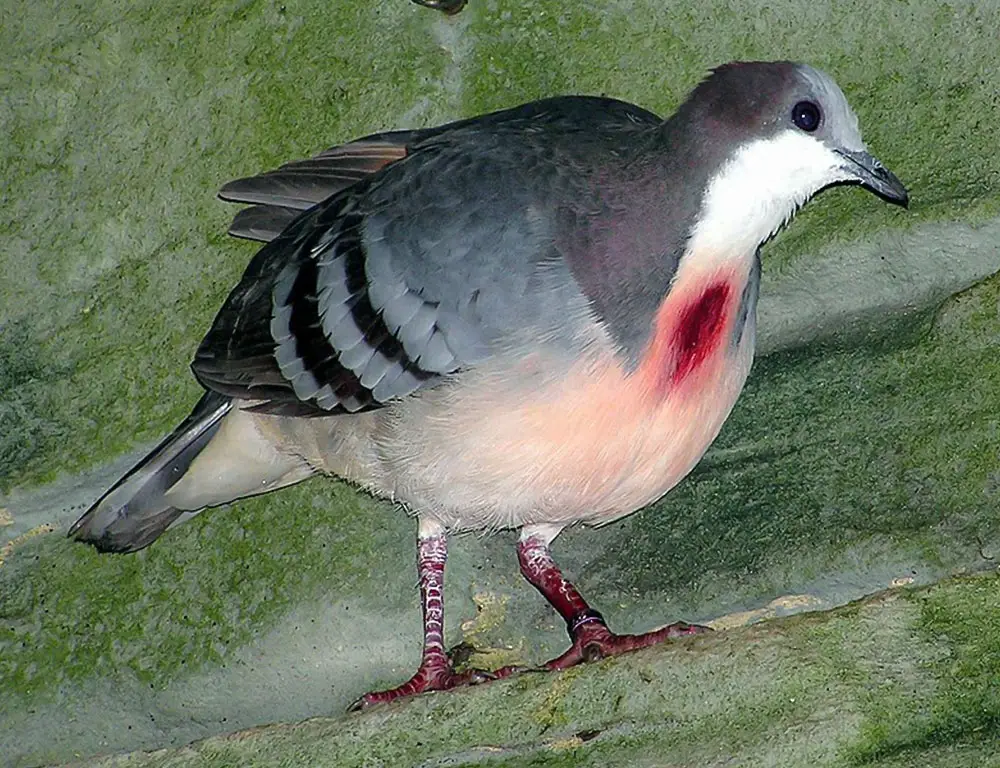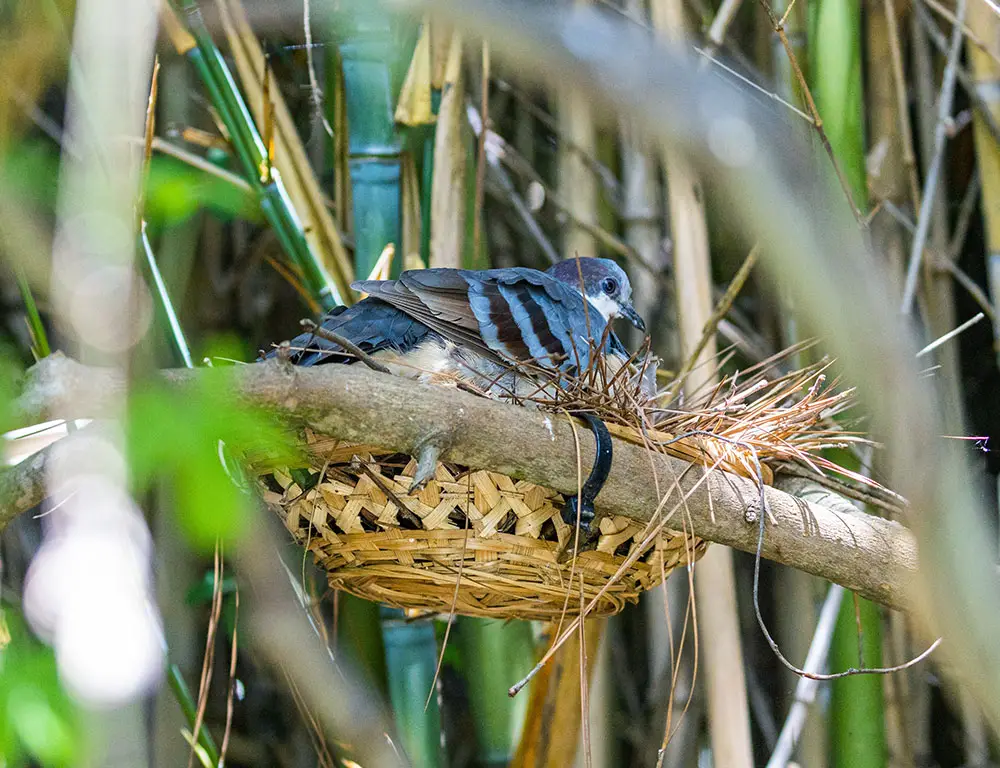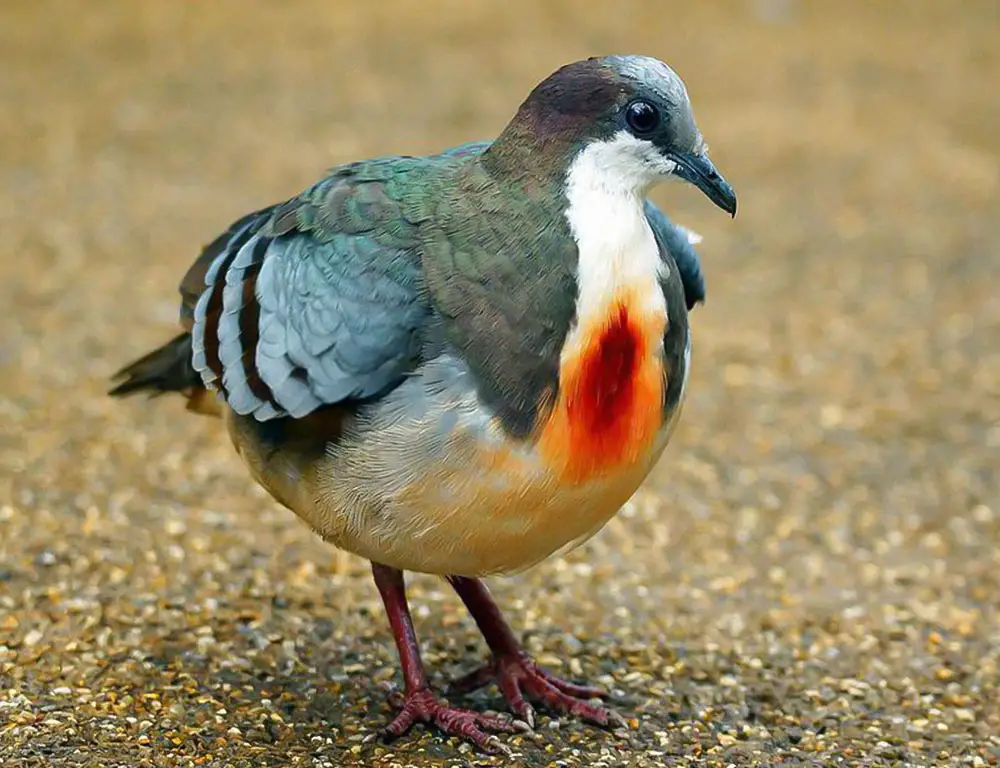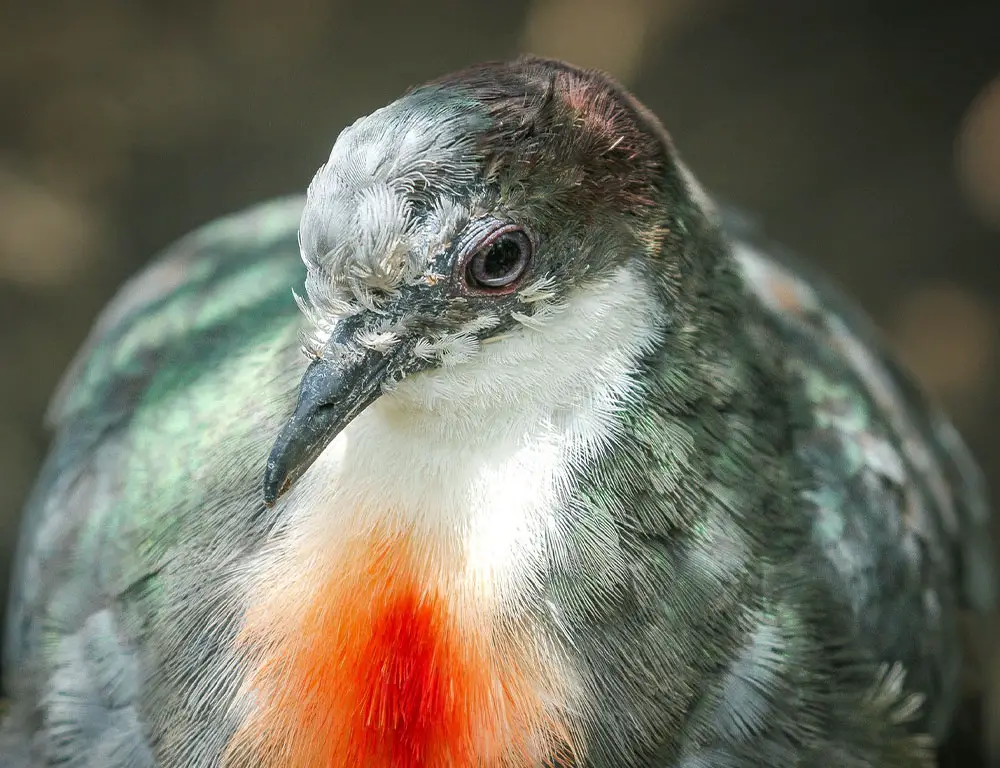The Luzon Bleeding-Heart (Gallicolumba luzonica) stands as a captivating symbol of the rich biodiversity in the Philippines.
Endemic to the island of Luzon, this bird species captivates with its striking appearance, featuring a vibrant splash of red on its breast resembling a bleeding heart.
Beyond its aesthetic allure, the Luzon Bleeding-Heart plays a crucial ecological role within its forested habitats, contributing to seed dispersal and maintaining the balance of its ecosystems.
As we delve into the fascinating world of the Luzon Bleeding-Heart, we uncover its unique physical characteristics, cultural significance, and conservation importance in the face of environmental threats.

Characteristics Of Luzon Bleeding-Heart
The Luzon Bleeding-Heart (Gallicolumba luzonica) is a captivating bird endemic to the Philippines, renowned for its unique characteristics and cultural significance. Here are some common traits associated with this species
Physical Characteristics
The Luzon Bleeding-Heart (Gallicolumba luzonica) is a captivating bird species endemic to the Philippines, known for its striking appearance and unique features. Here are seven physical characteristics that distinguish this bird:
Plumage
The Luzon Bleeding-Heart is named for the conspicuous splash of bright red coloration on its breast, resembling a bleeding heart. This distinctive feature contrasts sharply with the bird’s slate-gray upperparts and wings, creating a stunning visual display.
Size
This species is relatively small, measuring around 25 to 30 centimeters in length, with a wingspan of approximately 35 to 40 centimeters. Despite its compact size, the Luzon Bleeding-Heart has a robust build and a rounded body shape.
Crest
A prominent feature of the Luzon Bleeding-Heart is its elegant crest of feathers on the crown of its head. The crest is often raised in a display posture, adding to the bird’s overall charm and allure.
Red Eye Ring
Another striking characteristic of the Luzon Bleeding-Heart is its vibrant red eye ring, which encircles its deep red eyes. This eye ring contrasts beautifully with the bird’s plumage, enhancing its appeal.
Tail
The Luzon Bleeding-Heart has a short, rounded tail, which is often held cocked upwards while perched. The tail feathers are intricately patterned, adding to the bird’s aesthetic appeal.
Legs and Feet
Like other ground-dwelling pigeons, the Luzon Bleeding-Heart has sturdy legs and feet adapted for walking and perching. Its feet have sharp claws for gripping branches and navigating its forest habitat.
Sexual Dimorphism
While males and females of the species share similar plumage patterns, males may exhibit slightly brighter and more extensive red coloration on their breast feathers than females. This subtle difference in coloration helps distinguish between the sexes.
Distribution And Habitat
The Luzon Bleeding-Heart is found exclusively on the Philippine island of Luzon, inhabiting dense tropical forests and wooded areas. It prefers habitats with thick undergrowth and diverse plant species, providing ample cover and food sources.
Behavior And Ecology
This species is primarily ground-dwelling, foraging for seeds, fruits, and small invertebrates on the forest floor. It is often observed creeping through the underbrush, utilizing its camouflage to evade predators and locate food efficiently.
Cultural Depiction
The striking appearance of the Luzon Bleeding-Heart has inspired various cultural depictions in Filipino folklore and art. It is often celebrated as a symbol of beauty and resilience, representing the rich natural heritage of the Philippines.
Conservation Status
Due to habitat loss and fragmentation caused by deforestation and human encroachment, the Luzon Bleeding-Heart faces significant conservation challenges.
It is classified as Near Threatened on the IUCN Red List, highlighting the importance of conservation efforts to protect its remaining habitat and populations.
The Luzon Bleeding-Heart embodies a unique blend of ecological significance and cultural symbolism in the Philippines.
Its distribution, behavior, and role in its ecosystem underscore the importance of conservation initiatives to ensure the continued survival of this iconic bird species.
Taxonomy
Here’s a simplified table outlining the taxonomy and classification of the Luzon Bleeding-Heart (Gallicolumba luzonica):
| Taxonomy Level | Classification |
| Kingdom | Animalia |
| Phylum | Chordata |
| Class | Aves |
| Order | Columbiformes |
| Family | Columbidae |
| Genus | Gallicolumba |
| Species | Gallicolumba luzonica |
This classification reflects the evolutionary relationships and taxonomic placement of the Luzon Bleeding-Heart within the animal kingdom, chordate phylum, aves class, columbiformes order, columbidae family, Gallicolumba genus, and its specific species name, Gallicolumba luzonica.
Nesting Habit

Here’s a simplified table outlining the nesting habits of the Luzon Bleeding-Heart (Gallicolumba luzonica):
| Nesting Habit | Description |
| Nest Type | Luzon Bleeding-Hearts build simple platform-style nests made of twigs, leaves, and other plant materials, typically placed in dense vegetation. |
| Nest Placement | Nests are often located in the lower branches of trees or shrubs within the forest understory, providing shelter and concealment. |
| Breeding Season | Breeding typically occurs during the wet season, which varies depending on the region but often coincides with increased food availability. |
| Clutch Size | Luzon Bleeding-Hearts typically lay one or two eggs per clutch, although clutch size may vary depending on food availability. |
| Incubation Period | Both male and female Bleeding-Hearts share incubation duties, with eggs hatching after 14 to 18 days. |
| Parental Care | Both parents contribute to nest-building, incubating eggs, and caring for the hatchlings until they fledge and become independent. |
This table provides an overview of the nesting habits of the Luzon Bleeding-Heart, including nest type, placement, breeding season, clutch size, incubation period, and parental care.
These nesting behaviors reflect the species’ reproductive strategies and adaptation to its forest habitat.
Ranging Map
The ranging map of the Luzon Bleeding-Heart (Gallicolumba luzonica) illustrates the distribution of this captivating bird species within the Philippines.
As its name suggests, the Luzon Bleeding-Heart is primarily found on the island of Luzon, which is the largest and most populous island in the Philippine archipelago.
Within Luzon, this bird inhabits dense tropical forests and wooded areas, particularly in the northern and central regions of the island.
While its range may extend to neighboring islands in the Philippines, including nearby smaller islands within the Luzon group, the Luzon Bleeding-Heart’s distribution remains largely restricted to Luzon’s forested habitats.
Conservation efforts focused on preserving and restoring the forests of Luzon are crucial for safeguarding the remaining populations of this iconic and culturally significant bird species.
Where Is The Luzon Bleeding Heart Found?

The Luzon Bleeding-Heart (Gallicolumba luzonica) is predominantly found on the Philippine island of Luzon, inhabiting various forested areas and habitats across the island. Here are seven specific places where the Luzon Bleeding-Heart can be found:
Sierra Madre Mountain Range
Within Luzon, the Luzon Bleeding-Heart is commonly sighted in the Sierra Madre Mountain Range, a vast and biodiverse region known for its dense forests and rugged terrain.
This mountain range spans several provinces in Luzon, providing ample habitat for the bird to thrive.
Bataan Peninsula
The Luzon Bleeding-Heart can also be found in the Bataan Peninsula, a picturesque area on Luzon’s western coast. Here, the bird inhabits forests and woodlands, where it forages for food amidst the lush vegetation.
Subic Bay Freeport Zone
Within the province of Zambales, the Luzon Bleeding-Heart is known to inhabit the Subic Bay Freeport Zone, a protected area known for its rich biodiversity and pristine forests. The bird can be observed in the dense vegetation of this coastal region.
Mount Makiling
Mount Makiling, a dormant volcano located in the Laguna province, is another Luzon Bleeding-Heart habitat. The bird is often spotted in the mountain’s montane forests and lower slopes, where it feeds on fruits and seeds.
Quezon National Park
In the province of Quezon, the Luzon Bleeding-Heart is found within Quezon National Park, a protected area known for its diverse flora and fauna. The bird can be found in the park’s dense forests, where it roams amidst the towering trees.
Aurora Memorial National Park
The Luzon Bleeding-Heart is also present in Aurora Memorial National Park, located in the province of Aurora. This protected area encompasses a range of habitats, including lowland and montane forests, providing suitable habitat for the bird.
Polillo Islands
Finally, the Luzon Bleeding-Heart is found on the Polillo Islands, a group of islands located off the eastern coast of Luzon. Here, the bird inhabits the islands’ forests, contributing to the rich biodiversity of this island chain.
The Luzon Bleeding-Heart is distributed across various locations on the island of Luzon, from the Sierra Madre Mountain Range to coastal areas and protected parks.
Its presence in these diverse habitats highlights the bird’s adaptability and importance within Luzon’s ecosystems.
7 Interesting Personality Of Luzon Bleeding-Hearts

While birds don’t possess personalities in the same way humans do, there are exciting traits and behaviors exhibited by the Luzon Bleeding-Heart (Gallicolumba luzonica) that make them fascinating to observe:
1. Shy And Elusive
Luzon Bleeding-Hearts are known for their elusive nature, often shying away from human presence and preferring to stay hidden within the dense foliage of their forest habitat.
2. Graceful Movement
When spotted, these birds display graceful movements as they hop along the forest floor or perch delicately on branches, showcasing their agility and elegance.
3. Vocalizations
Luzon Bleeding-Hearts have a distinctive call, characterized by soft cooing sounds that echo through the forest. Their vocalizations add to the ambiance of their habitat and help them communicate with other members of their species.
4. Courtship Displays
During the breeding season, male Luzon Bleeding-Hearts perform elaborate courtship displays to attract mates. These displays may involve puffing up their feathers, bobbing their heads, and fluttering their wings to impress females.
5. Family Bonds
Once pairs bond, Luzon Bleeding-Hearts exhibit strong family ties, with both parents participating in nest-building, incubating eggs, and caring for the young chicks until they fledge.
6. Foraging Behavior
These birds are skilled foragers, searching for seeds, fruits, and small invertebrates on the forest floor. They use their sharp beaks to probe leaf litter and undergrowth for food.
7. Camouflage
Luzon Bleeding-Hearts rely on their muted plumage and ability to blend into their surroundings to avoid detection by predators. Their camouflage helps them stay hidden while foraging and nesting in the dense vegetation of their habitat.
While Luzon Bleeding-Hearts may not possess personalities in the human sense, their unique behaviors and characteristics make them intriguing subjects for observation and study in their natural environment.
FAQs
Why is it called the “Bleeding-Heart”?
The name “Bleeding-Heart” refers to the bright red patch on the bird’s breast, which resembles a bleeding heart. This distinctive feature has inspired the bird’s common name and adds to its visual allure.
What is the habitat of the Luzon Bleeding-Heart?
Luzon Bleeding-Hearts inhabit dense tropical forests and wooded areas on the island of Luzon. They prefer habitats with thick undergrowth and diverse vegetation, providing ample cover and food sources.
What does the Luzon Bleeding-Heart eat?
The Luzon Bleeding-Heart primarily feeds on seeds, fruits, and small invertebrates on the forest floor. Its diet includes various plant materials and insects, which it forages for amidst the dense vegetation of its habitat.
Is the Luzon Bleeding-Heart endangered?
The Luzon Bleeding-Heart is currently classified as Near Threatened on the IUCN Red List. It faces threats from habitat loss and degradation due to deforestation and human encroachment, reducing its available habitat and populations.
How can I help conserve the Luzon Bleeding-Heart?
You can contribute to the conservation of the Luzon Bleeding-Heart by supporting habitat protection initiatives, advocating for sustainable forestry practices, and raising awareness about the importance of preserving its forest habitat.
Additionally, supporting local conservation organizations and participating in eco-tourism activities can help promote conservation efforts to protect this iconic bird species.
Conclusion
The Luzon Bleeding-Heart serves as a poignant reminder of the beauty and fragility of the Philippines’ natural heritage. This bird species deserves our admiration and protection as an iconic symbol of Luzon’s forests.
Discover the mesmerising beauty of the Luzon Bleeding-Heart, an iconic bird species indigenous to the Philippines with a bright red breast.
Conservation efforts to preserve its habitat are essential to ensure the survival of the Luzon Bleeding-Heart and other endemic species, safeguarding the biodiversity and ecological integrity of Luzon’s ecosystems for future generations to cherish and appreciate.
